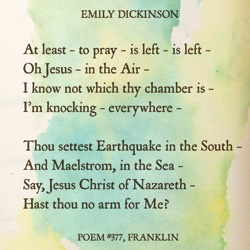How to Read a Poem
By Susan VanZanten, SPU Professor of English
A good poem can be read repeatedly, in multiple ways. To enjoy a poem, you don't have to understand the poem fully the first time you read it. Instead, each time you read the poem, you can focus on something new by asking different questions. Here are a few reading strategies that can help you experience some aspects of poetry more fully:
- Sound: Read the poem aloud and listen to its sounds and rhythms, such as rhymes, meter, alliteration, and assonance. What does it sound like?
- Context: Who is speaking? Does the poem address someone? In what kind of situation is the poem taking place? Is it describing a scene, emotion, or experience?
- Words: Consider the denotation and emotional connotation of each word, using a dictionary if necessary. Choose one or two striking words to mull over.
- Image: What kind of pictures does the poem draw with its words? Are there striking metaphors that deepen its meaning?
- Allusion: Are there any aspects of the poem that refer to another text or something from history? What meaning does that add or resonances does it create?

Try answering these questions for this poem by Emily Dickinson, written around 1862.
Some initial answers:
- Sound: It flows with a simple rhythm and rhyme, but the repetition and dashes of line 1 sound tired and halting. In the last stanza, the repeated "s" sounds are harsh and grating.
- Context: A solitary, troubled voice is pleading for help, directly addressing Jesus twice.
- Words: "Maelstrom" is a peculiar-looking, weird word. Referring to a violent Norwegian whirlpool, it evokes strangeness, terror, and confusion.
- Image: I see a distraught person wildly knocking everywhere, but not finding Jesus' house, for it is invisible.
- Allusion: "Knocking – everywhere" reminds me of Matthew 7:7, the "arm" of the Lord was stretched out to save Peter from a watery grave in Matthew 14:22–33.
